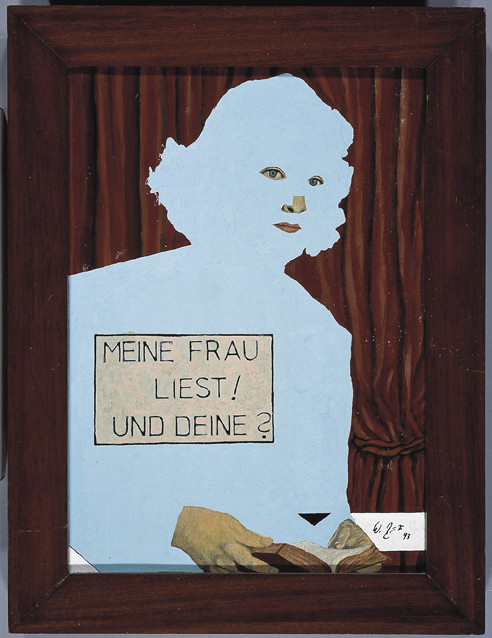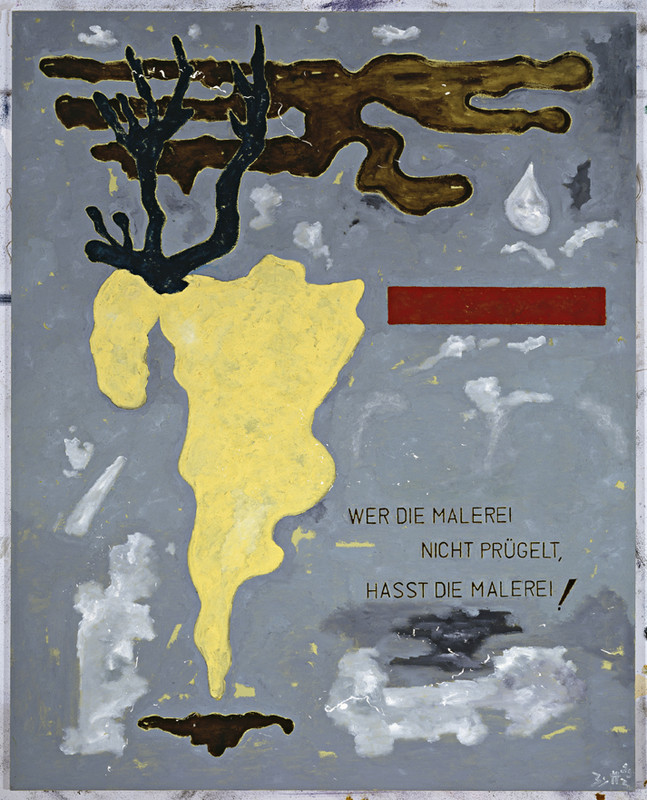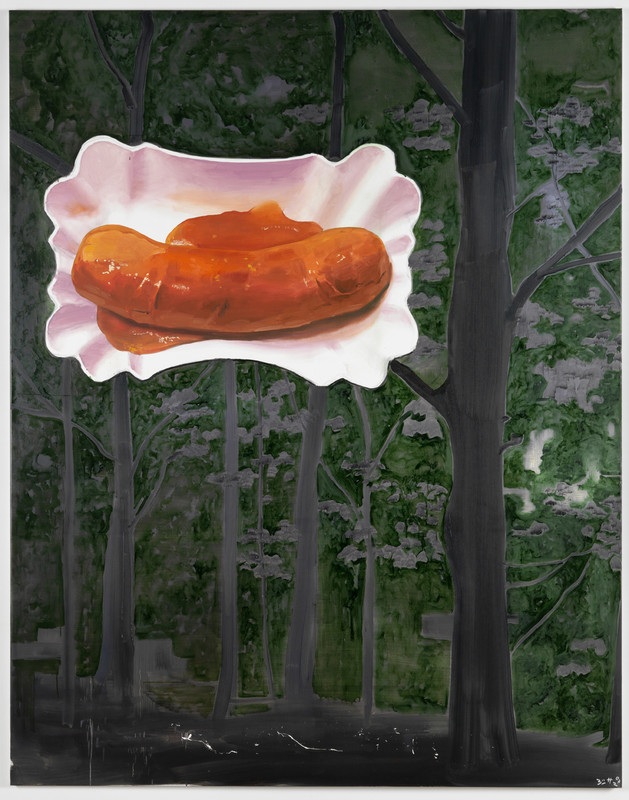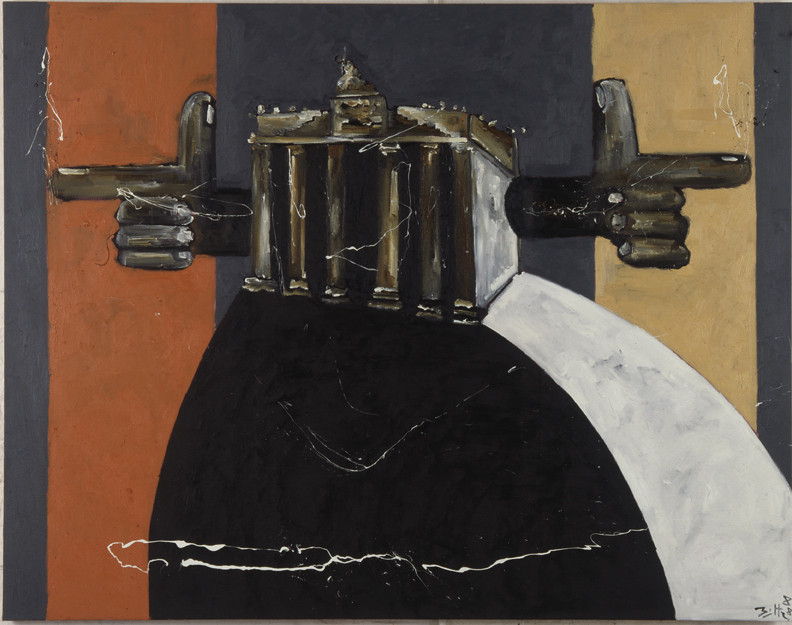Werner Büttner. Gemeine Wahrheiten
06 Apr - 22 Sep 2013

Werner Büttner, „Badende Russen II“, 1982,
Öl auf Leinwand, 150 x 190 cm,
Sammlung Landesbank Baden-Württemberg
© Werner Büttner, Foto: Archiv Sammlung Landesbank Baden-Württemberg, Harro
Wolter
Öl auf Leinwand, 150 x 190 cm,
Sammlung Landesbank Baden-Württemberg
© Werner Büttner, Foto: Archiv Sammlung Landesbank Baden-Württemberg, Harro
Wolter

Werner Büttner, „Ein kulturimperialistisches Bubenstück“, 1987,
11 Figuren aus Rosenholz, bemalt, jede ca. 45 x 10 x 10 cm, 11 Skizzen,
Mischtechnik auf Papier, 29,8 x 21 cm, Teilansicht,
Sammlung Grässlin, St. Georgen
© Werner Büttner, Foto: Thomas Berger, St. Georgen
11 Figuren aus Rosenholz, bemalt, jede ca. 45 x 10 x 10 cm, 11 Skizzen,
Mischtechnik auf Papier, 29,8 x 21 cm, Teilansicht,
Sammlung Grässlin, St. Georgen
© Werner Büttner, Foto: Thomas Berger, St. Georgen

Werner Büttner, „Die Probleme des Minigolfs in der europäischen Malerei Nr. 4“, 1982,
Öl auf Leinwand, 150 x 120 cm, Privatsammlung (courtesy Galerie Max Hetzler)
© Werner Büttner, Foto: Harro Wolter
Öl auf Leinwand, 150 x 120 cm, Privatsammlung (courtesy Galerie Max Hetzler)
© Werner Büttner, Foto: Harro Wolter

Werner Büttner, „Meine Frau liest und Deine?“, 1993,
mit Öl übermalte Laienarbeit auf Holz, 46 x 32 cm,
Sammlung Falckenberg
© Werner Büttner, Foto: Egbert Haneke
mit Öl übermalte Laienarbeit auf Holz, 46 x 32 cm,
Sammlung Falckenberg
© Werner Büttner, Foto: Egbert Haneke

Werner Büttner, „Wer die Malerei nicht prügelt, hasst die Malerei“, 1999,
Öl auf Leinwand, 150 x 120 cm
© Werner Büttner, Foto: Egbert Haneke
Öl auf Leinwand, 150 x 120 cm
© Werner Büttner, Foto: Egbert Haneke

Werner Büttner, „Der romantische Imperativ“, 2007,
Öl auf Leinwand, 240 x 190 cm, courtesy Galerie Grässlin
© Werner Büttner, Foto: Egbert Haneke
Öl auf Leinwand, 240 x 190 cm, courtesy Galerie Grässlin
© Werner Büttner, Foto: Egbert Haneke

Werner Büttner, „Der antifaschistische Schutzwall“, 1988,
Öl auf Leinwand, 190 x 240 cm, Sammlung Grässlin, St. Georgen
© Werner Büttner, Foto: Thomas Berger, St. Georgen
Öl auf Leinwand, 190 x 240 cm, Sammlung Grässlin, St. Georgen
© Werner Büttner, Foto: Thomas Berger, St. Georgen

Werner Büttner, „Schrecken der Demokratie (Selbstbildnis als Schädling im Apfelbaum)“,
1984
Mischtechnik auf Papier, 29,8 x 21 cm,
Sammlung Grässlin, St. Georgen
© Werner Büttner, Foto: Thomas Berger, St. Georgen
1984
Mischtechnik auf Papier, 29,8 x 21 cm,
Sammlung Grässlin, St. Georgen
© Werner Büttner, Foto: Thomas Berger, St. Georgen
An exhibition at the ZKM | Museum of Contemporary Art
Opening: Fri, April 5, 2013, 7 p.m., ZKM_Foyer
With the retrospective “Werner Büttner. Gemeine Wahrheiten” the ZKM holds the most comprehensive exhibition to date of works by the Hamburg artist.
Together with Martin Kippenberger and Albert Oehlen, he has exerted a sustained influence on the European art scene since the early 1980s. Paintings, drawings and sculptures testify to Büttner’s ingenuity, his sense of irony, but also his biting derision of social realities. With around 220 paintings, drawings and sculptures, the retrospective underscores Büttner’s significance with respect to the development of German painting at the close of the 20th century, characterizing him as one of the central figures and pioneers. The focus of the exhibition is Werner Büttner the painter, who, following the reinvigoration of figurative painting in the 1960s and 1970s, began to break with its illusionism and to finally strip it of all bourgeois elements.
A comprehensive publication will appear in conjunction with the exhibition.
Curators: Peter Weibel and Andreas Beitin
Opening: Fri, April 5, 2013, 7 p.m., ZKM_Foyer
With the retrospective “Werner Büttner. Gemeine Wahrheiten” the ZKM holds the most comprehensive exhibition to date of works by the Hamburg artist.
Together with Martin Kippenberger and Albert Oehlen, he has exerted a sustained influence on the European art scene since the early 1980s. Paintings, drawings and sculptures testify to Büttner’s ingenuity, his sense of irony, but also his biting derision of social realities. With around 220 paintings, drawings and sculptures, the retrospective underscores Büttner’s significance with respect to the development of German painting at the close of the 20th century, characterizing him as one of the central figures and pioneers. The focus of the exhibition is Werner Büttner the painter, who, following the reinvigoration of figurative painting in the 1960s and 1970s, began to break with its illusionism and to finally strip it of all bourgeois elements.
A comprehensive publication will appear in conjunction with the exhibition.
Curators: Peter Weibel and Andreas Beitin
